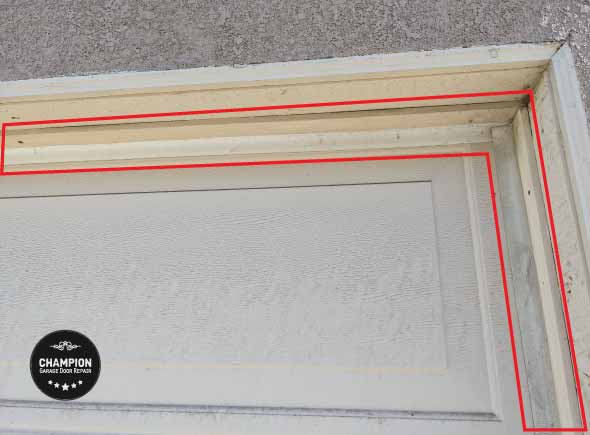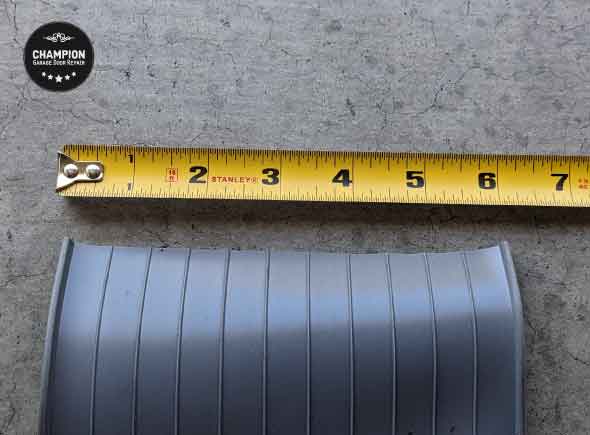A garage door weather seal, also known as a weather stripping, is a component installed along the edges of the garage door to provide a tight seal and prevent the infiltration of air, water, dust, insects, and other unwanted elements. Weather sealing your garage door offers several important benefits. Here are five key reasons to weather seal your garage door:
1. Pest Control
Weather sealing helps to deter pests, insects, and small animals from entering your garage. By closing off gaps and potential entry points, you can reduce the risk of infestations and damage caused by rodents, insects, or other unwanted critters.
2. Rust Prevention
Weather sealing your garage door can help extend the garage door’s lifespan by reducing exposure to weather conditions. It protects the door from moisture, dust particles, salty air, and other environmental elements, helping to prevent deterioration, warping, or corrosion.
Exposure to moisture and humidity can lead to various problems. When metal components such as springs, hinges, tracks, cables, bearings, door openers, door panels and other metal mechanisms come into contact with moisture, several undesirable effects can occur. In coastal areas such as Huntington Beach, Seal Beach, Long Beach, Newport Beach, Capistrano Beach and environments near the beach where there is salty air, the salt particles in the air can settle on the metal components of the door.
One of the most common issues caused by exposure to moisture, humidity, and salty air is the formation of rust on metal surfaces. Rust can weaken and deteriorate these metal components over time, compromising their structural integrity and leading to premature breakage as well as more frequent repairs.

3. Dust and Debris Prevention
A weather-sealed garage door acts as a barrier against dirt, dust, pollen, and other contaminants. It helps to keep your garage cleaner and reduces the amount of dust that can enter your home from the garage. This is particularly important if you have sensitive equipment, vehicles, or allergies.
Exposure to dust particles can have damaging effects on the mechanisms of a garage door. One significant issue is the reduction in performance. Dust particles have the tendency to settle on various moving parts of the garage door, including gears, chains, belts, rollers, bearings, and the spring’s coil. As these particles accumulate, they increase friction and wear, ultimately leading to decreased efficiency and performance of the garage door over time.
Moreover, fine dust particles can also cause problems by contaminating lubricants. When lubricants become contaminated, they lose their effectiveness in reducing friction and protecting the door components. This can result in abrasive wear during operation, leading to premature failure of the garage door parts and a higher frequency of repairs required for the garage door.
In addition to affecting the mechanical aspects of the garage door, dust particles can also impact the electrical components of the garage door opener. When dust settles on the opener’s electrical components, it can create electrical resistance and interfere with connections. This interference can potentially lead to malfunctions, short circuits, and other electrical failures.
4. Water Protection
Weather sealing helps to keep rain and snow out of your garage. By sealing the gaps, you can prevent water from seeping in and causing damage to your garage door and belongings, such as vehicles, tools, or stored items. It also helps to minimize the risk of mold and mildew growth, which can thrive in damp environments.
5. Temperature Regulation
A weather-sealed garage door helps to regulate the temperature inside the garage. It acts as a barrier against outside temperatures, preventing heat or cold from entering the space.
Controlling the temperature inside the garage contributes to energy efficiency by minimizing heat transfer and reducing the need for excessive heating or cooling. This can result in cost savings on energy bills. Moreover, a controlled temperature helps protect temperature-sensitive items stored in the garage, such as electronics, paint, or perishable goods, from potential damage caused by extreme heat or cold.
This can be particularly beneficial if your garage is attached to your house or used as a workshop, storage area, or living space, as it helps maintain a comfortable and consistent temperature year-round.
What is Garage Door Weather Stripping Made Out Of?
Garage door weather stripping is available in various materials, chosen based on the specific type and usage. Common materials for garage door weather stripping include rubber, typically used for the bottom seal, and vinyl, commonly used to seal the top and sides of the garage door.
How to Test Your Garage Door Weather Stripping?
Testing your garage door weather stripping is a simple process that can help determine its effectiveness and if the weather stripping requires repair or replacement to maintain an efficient seal. Here’s how to test your garage door weather stripping:
- Basic Inspection: Begin by visually inspecting the weather stripping along the edges of your garage door, looking for signs of wear, damage, or gaps. Close the garage door and carefully observe the perimeter from inside the garage during the daytime. Pay attention to any visible gaps between the weather stripping and the door or any light seeping through. Run your hand along the edges to feel for any air drafts.
- The Paper Test: Start by placing a piece of paper on the closing point of the door while it is open. Close the garage door, and then try to pull the paper out. If the paper can be easily pulled out without any resistance, it suggests that the bottom seal may need to be adjusted or replaced to create a tighter seal. Note that even with a tight seal, it is still possible for the paper to be pulled out effortlessly.
- Water Test: To test your garage door bottom seal, you can use a bucket filled with water or a garden hose. Slowly pour water onto the floor near the bottom section of the garage door, moving the bucket or hose from side to side. Then, go back inside and closely observe the floor for any signs of water penetration. Pay attention to any issues you notice, as they may indicate potential gaps in the weather stripping that require repair or adjustment. This test helps ensure that your garage door is adequately sealed and prepared for the winter.
- Inspect for Moisture or Water Infiltration: After a rainfall, inspect the interior of your garage for any signs of moisture or water ingress. Check the areas near the weather stripping for dampness, water droplets, or signs of water damage. If moisture is present, it may suggest that the weather stripping is not effectively keeping out water and needs attention.
What to Do if Your Garage Door Is Not Properly Sealed
If you find that your garage door is not properly sealed, here are the best steps you can take to address the issue:
Fixing Gaps on the Top and Sides of Your Garage Door
If your garage door has gaps on the top and sides, there are a couple of ways to address the issue. The first option is to remove the weather stripping and nails, then remount it closer to the door. However, it’s important to avoid mounting the weather stripping too tightly against the door to prevent binding. The second option is to adjust the door and tracks, aligning the door closer to the weather stripping. This can be achieved by adjusting the jamb brackets and the door’s top brackets. If the weather stripping is already dried out, it may need to be repaired or replaced entirely.
Fixing Gaps on the Bottom of Your Garage Door
If your garage door has gaps on the bottom, there are a few steps you can take to address the issue. First, try adjusting the garage door opener to close farther down, which will apply more pressure on the bottom seal. If the gaps persist, it may indicate that the bottom seal is already worn out and needs to be replaced. Alternatively, it’s also possible that the garage door is not properly aligned, which can be repaired by adjusting the torsion assembly.
In some cases, gaps on the bottom may be a result of an uneven concrete slab in the garage. This can occur due to settling or shifting of the underlying soil, leading to sinking and cracking of the concrete. To fix this issue, you can install a 6″ bottom seal on the garage door to help compensate for the unevenness. In extreme cases, where the floor is severely uneven, using a self-leveling compound may be necessary to repair and level the concrete slab.

When replacing your garage door bottom seal, it’s important to note that older seals, especially those with a single channel and rounded corners, may no longer be available. In such cases, it will be necessary to also replace the bottom retainer, which is the channel piece that the seal slides into.
Ultimately, weather stripping significantly improves the durability and performance of a garage door. By effectively sealing gaps and cracks, it creates a protective barrier against air, water, debris, and pests. This insulation minimizes temperature fluctuations, reduces the risk of rust and water damage, and extends the door’s lifespan. With improved durability, efficient performance, and fewer repairs required, weather stripping your garage door and maintaining it properly ensures a reliable and long-lasting garage door system.







